Sensitivity of Peru’s Economic Growth Rate to Regional Climate Variability
Abstract
1. Introduction
2. Data and Methods
3. Results
3.1. Peru Growth Rate and Global Drivers
3.2. Composite High–Low Growth
3.3. Multi-Variate Algorithm and Long-Term Change
4. Concluding Discussion
Funding
Data Availability Statement
Acknowledgments
Conflicts of Interest
Appendix A

References
- Wilson, C. Severe El Niño Stunted Peruvian Children’s Height. New Scientist. 2014, p. 26608. Available online: https://www.newscientist.com/article/dn26608-severe-el-nino-stunted-peruvian-childrens-height/ (accessed on 1 July 2025).
- Royal Geographic Society (RGS). El Nino and Development in Peru. 2015. Available online: https://www.rgs.org/schools/resources-for-schools/el-nino-and-development-in-peru (accessed on 1 July 2025).
- International Monetary Fund (IMF). Country Report No. 24/134: Peru; International Monetary Fund: Washington, DC, USA, 2024; p. 43. [Google Scholar]
- McPhaden, M.; Zebiak, S.; Glantz, M. ENSO as an integrating concept in earth science. Science 2006, 314, 1740–1745. [Google Scholar] [CrossRef] [PubMed]
- White, W.B. Tropical coupled Rossby waves in the Pacific ocean–atmosphere system. J. Phys. Oceanogr. 2000, 30, 1245–1264. [Google Scholar] [CrossRef]
- Roundy, P.E.; Kiladis, G.N. Observed relationships between oceanic kelvin waves and atmospheric forcing. J. Clim. 2006, 19, 5253–5272. [Google Scholar] [CrossRef]
- Jury, M.R.; Alfaro-Garcia, L. Peru north coast climate variability and regional ocean-atmosphere forcing. Coasts 2024, 4, 508–534. [Google Scholar] [CrossRef]
- Orlove, B.; Chiang, J.; Cane, M. Forecasting Andean rainfall and crop yield from the influence of El Niño. Nature 2000, 403, 68–71. [Google Scholar] [CrossRef] [PubMed]
- French, A.; Mechler, R.; Arestegui, M.; MacClune, K.; Cisneros, A. Root causes of recurrent catastrophe: The political ecology of El Niño-related disasters in Peru. Int. J. Disaster Risk Reduct. 2020, 47, 101539. [Google Scholar] [CrossRef]
- Cashin, P.; Mohaddes, K.; Raissi, M. Fair weather or foul, the macroeconomic effects of El Niño. J. Int. Econ. 2017, 106, 37–54. [Google Scholar] [CrossRef]
- Mendoza-Nava, A. Inequality in Peru: Reality and Risks. Oxfam Peru. 2015. Available online: https://cng-cdn.oxfam.org/peru.oxfam.org/s3fs-public/file_attachments/Inequality%20in%20Peru.%20Reality%20and%20Risks_4.pdf (accessed on 1 July 2025).
- Guevara, B.; Rodriguez, G.; Yamuca-Salvatierra, L. External Shocks and Economic Fluctuations in Peru: Empirical Evidence Using Mixture Innovation Models. Pontif. Cathol. Univ. Peru 2024. [Google Scholar] [CrossRef]
- Keating, A.; Venkateswaran, K.; Szoenyi, M.; MacClune, K.; Mechler, R. From event analysis to global lessons: Disaster forensics for building resilience. Nat. Hazards Earth Syst. Sci. 2016, 16, 1603–1616. [Google Scholar] [CrossRef]
- Jury, M.R. Environmental sensitivity of Caribbean economic growth rate. Adv. Stat. Climatol. Meteorol. Oceanogr. 2024, 10, 95–104. [Google Scholar] [CrossRef]
- Food & Agricultural Organization. (FAO) 2025. Available online: www.fao.org/faostat/en/#data/MK (accessed on 1 July 2025).
- Gelaro, R.; McCarty, W.; Suárez, M.J.; Todling, R.; Molod, A.; Takacs, L.; Randles, C.A.; Darmenov, A.; Bosilovich, M.G.; Reichle, R.; et al. The modern-era retrospective analysis for research and applications v2 (Merra2). J. Clim. 2017, 30, 5419–5454. [Google Scholar] [CrossRef] [PubMed]
- Penny, S.G.; Behringer, D.W.; Carton, J.A.; Kalnay, E. A hybrid global ocean data assimilation system at NCEP. Mon. Weather Rev. 2015, 143, 4660–4677. [Google Scholar] [CrossRef]
- Salvatteci, R.; Schneider, R.R.; Galbraith, E.; Field, D.; Blanz, T.; Bauersachs, T.; Crosta, X.; Martinez, P.; Echevin, V.; Scholz, F.; et al. Smaller fish species in a warm and oxygen-poor Humboldt Current system. Science 2022, 375, 101–104. [Google Scholar] [CrossRef] [PubMed]
- Takahashi, K.; Dewitte, B. Strong and moderate nonlinear El Niño regimes. Clim. Dyn. 2016, 46, 1627–1645. [Google Scholar] [CrossRef]
- Cane, M. The evolution of El Nino, past and future. Earth Planet. Sci. Lett. 2005, 230, 227–240. [Google Scholar] [CrossRef]
- Collins, M.; An, S.-I.; Cai, W.; Ganachaud, A.; Guilyardi, E.; Jin, F.-F.; Jochum, M.; Lengaigne, M.; Power, S.; Timmermann, A.; et al. The impact of global warming on the tropical Pacific Ocean and El Niño. Nat. Geosci. 2010, 3, 391–397. [Google Scholar] [CrossRef]
- Cai, W.; Santoso, A.; Collins, M.; Dewitte, B.; Karamperidou, C.; Kug, J.-S.; Lengaigne, M.; McPhaden, M.J.; Stuecker, M.F.; Taschetto, A.S.; et al. Changing El Niño–Southern Oscillation in a warming climate. Nat. Rev. Earth Environ. 2021, 2, 628–644. [Google Scholar] [CrossRef]
- Carey, M. In the Shadow of Melting Glaciers: Climate Change and Andean Society; Oxford University Press: New York, NY, USA, 2010. [Google Scholar]
- Lemos, M.C.; Kirchhoff, C.J.; Ramprasad, V. Narrowing the climate information usability gap. Nat. Clim. Chang. 2012, 2, 789–794. [Google Scholar] [CrossRef]
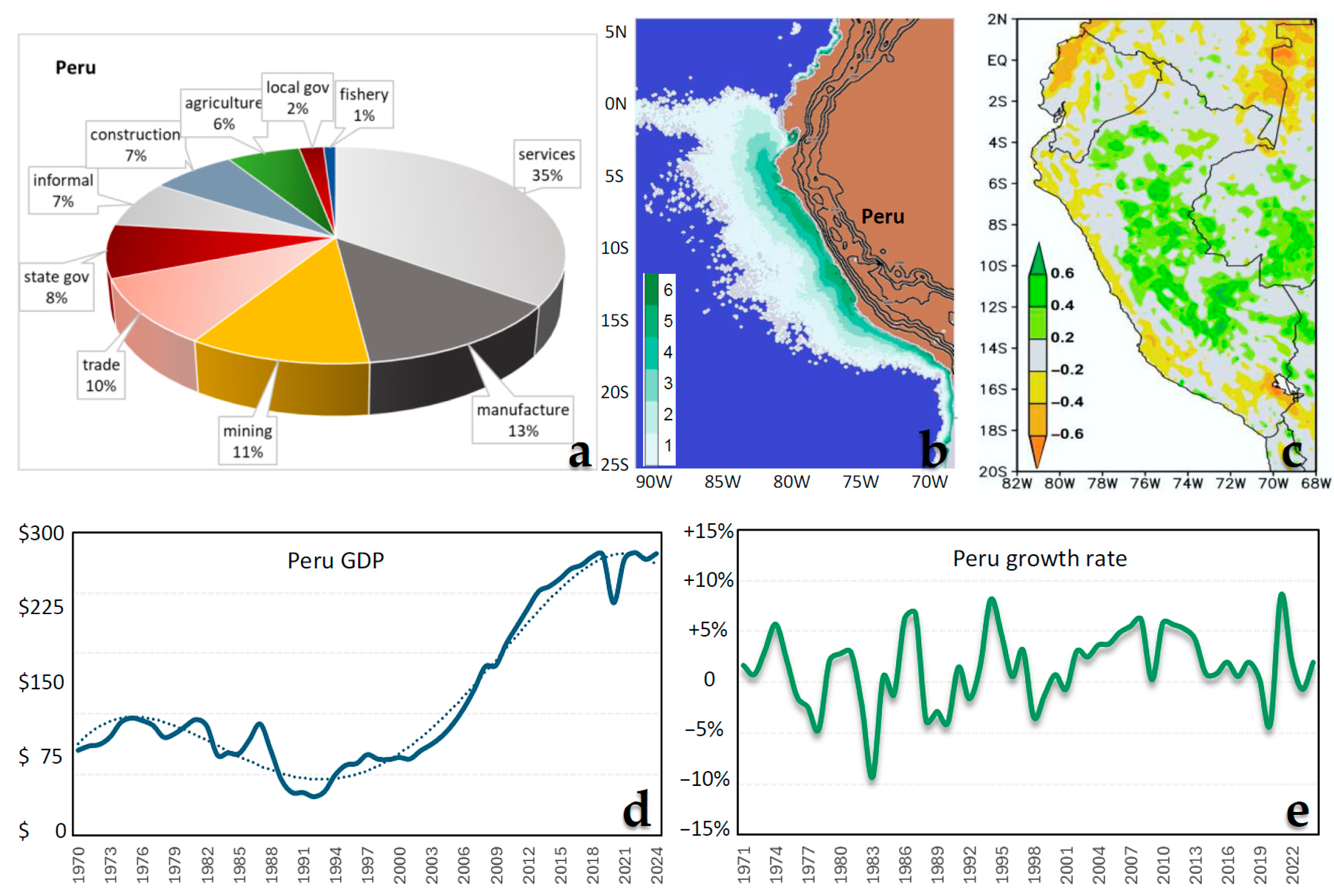
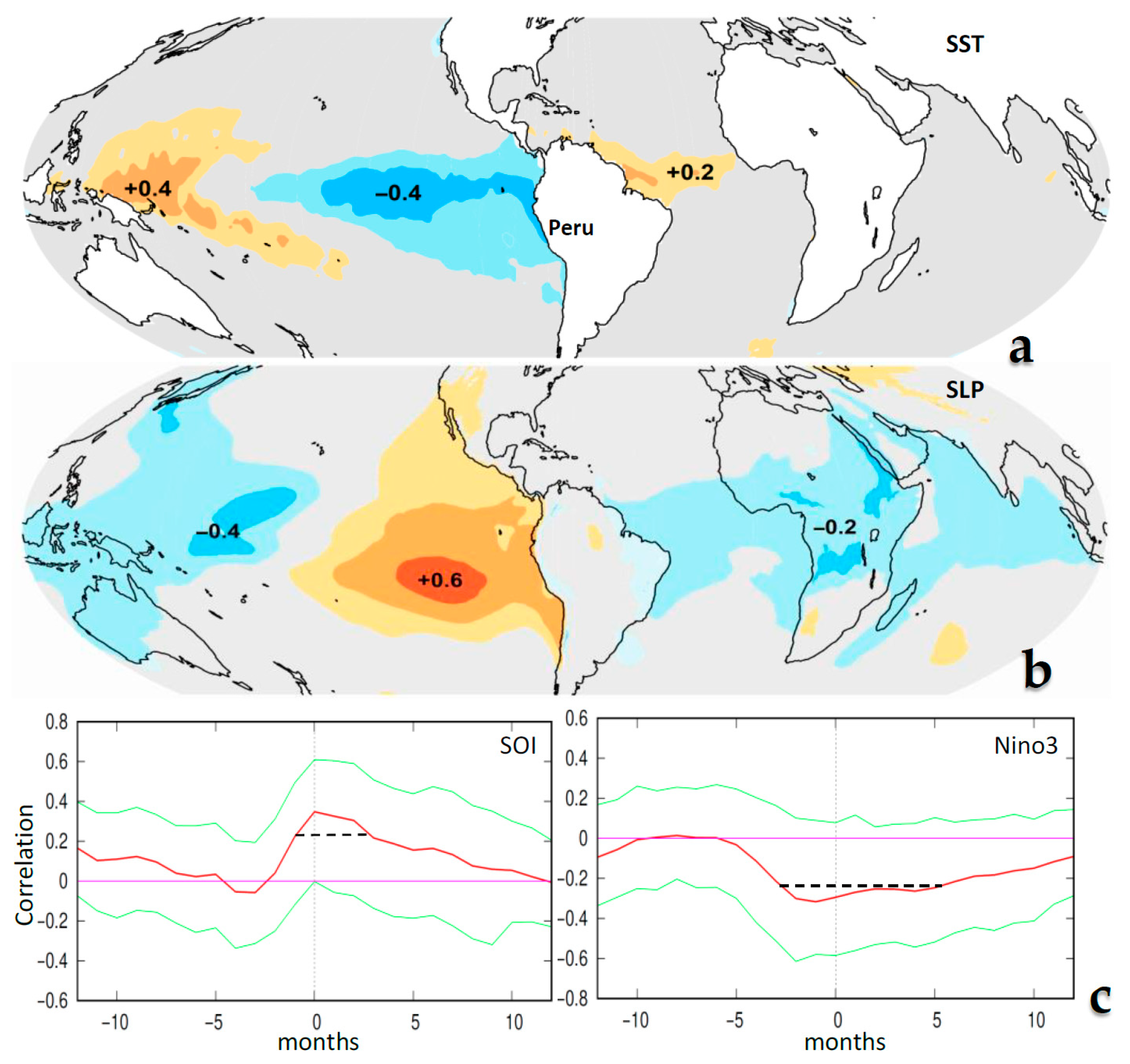
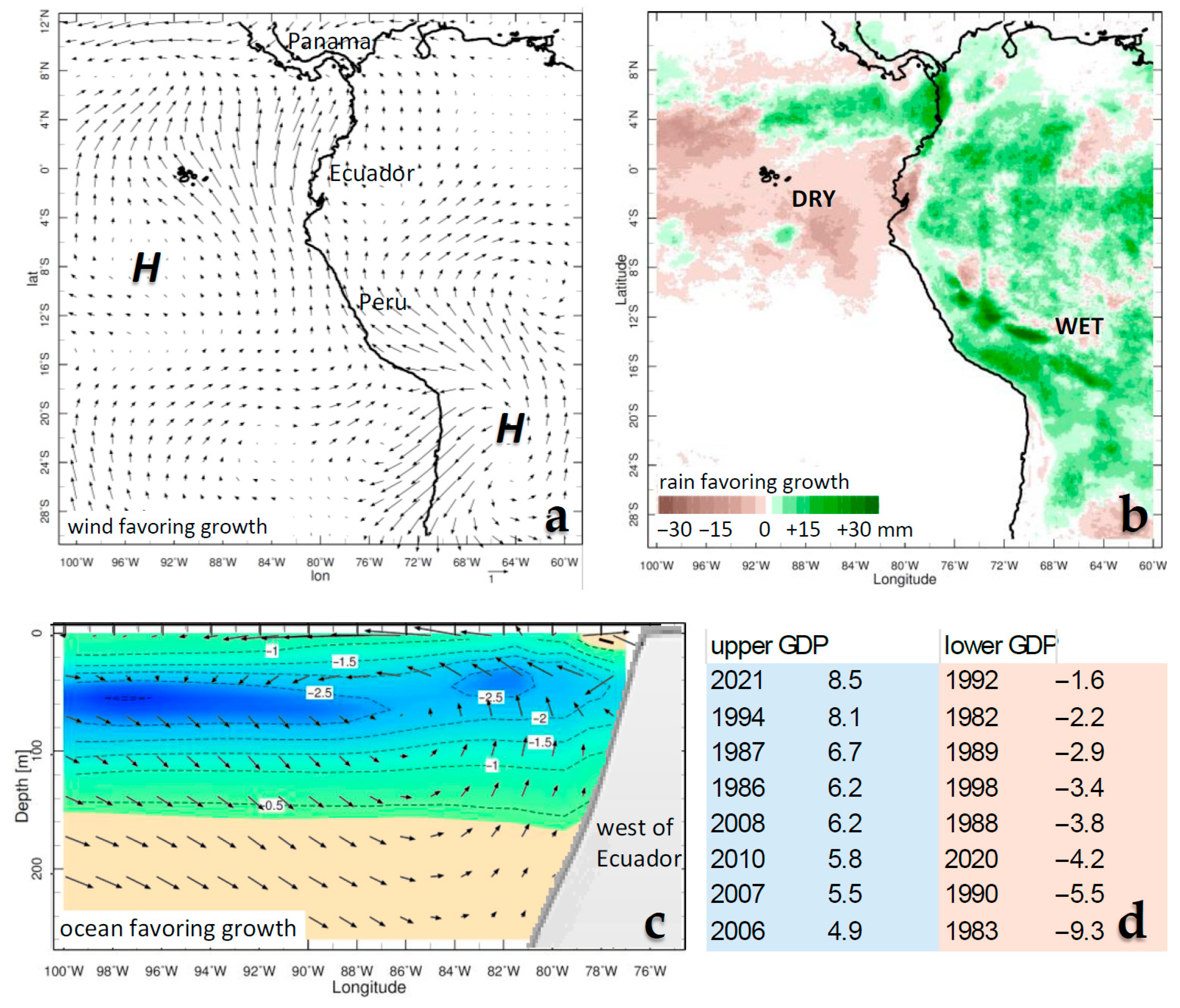
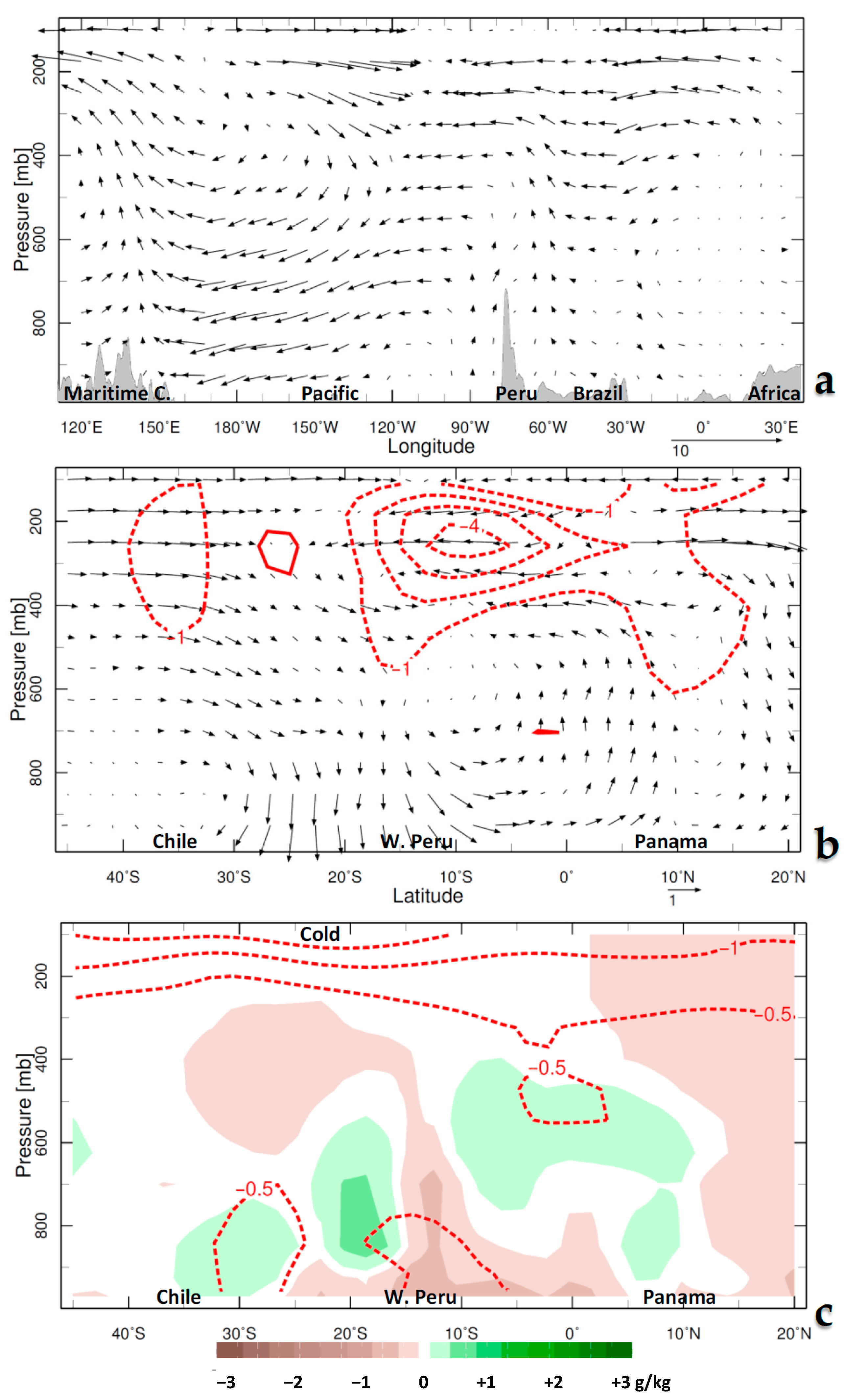
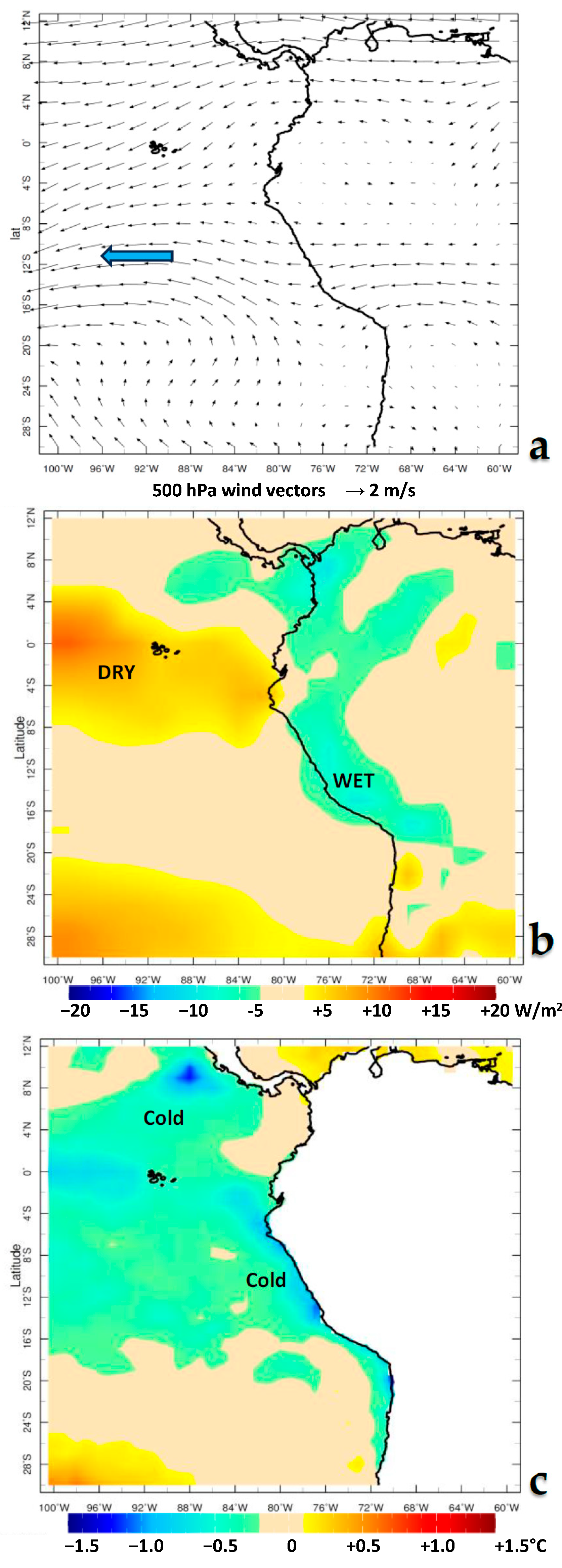
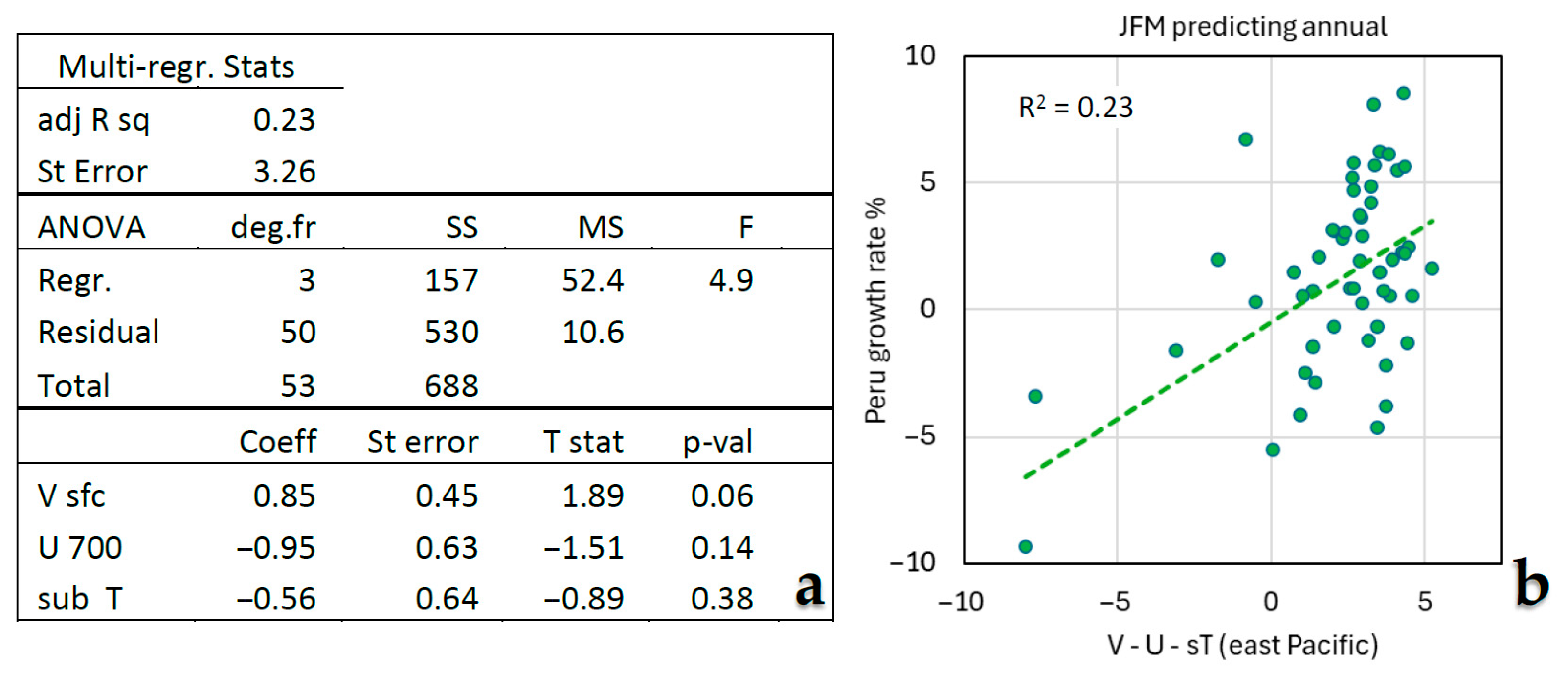
Disclaimer/Publisher’s Note: The statements, opinions and data contained in all publications are solely those of the individual author(s) and contributor(s) and not of MDPI and/or the editor(s). MDPI and/or the editor(s) disclaim responsibility for any injury to people or property resulting from any ideas, methods, instructions or products referred to in the content. |
© 2025 by the author. Licensee MDPI, Basel, Switzerland. This article is an open access article distributed under the terms and conditions of the Creative Commons Attribution (CC BY) license (https://creativecommons.org/licenses/by/4.0/).
Share and Cite
Jury, M.R. Sensitivity of Peru’s Economic Growth Rate to Regional Climate Variability. Climate 2025, 13, 216. https://doi.org/10.3390/cli13100216
Jury MR. Sensitivity of Peru’s Economic Growth Rate to Regional Climate Variability. Climate. 2025; 13(10):216. https://doi.org/10.3390/cli13100216
Chicago/Turabian StyleJury, Mark R. 2025. "Sensitivity of Peru’s Economic Growth Rate to Regional Climate Variability" Climate 13, no. 10: 216. https://doi.org/10.3390/cli13100216
APA StyleJury, M. R. (2025). Sensitivity of Peru’s Economic Growth Rate to Regional Climate Variability. Climate, 13(10), 216. https://doi.org/10.3390/cli13100216





